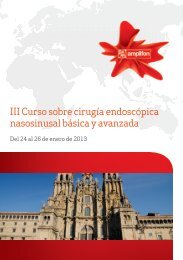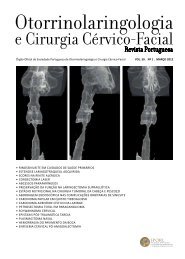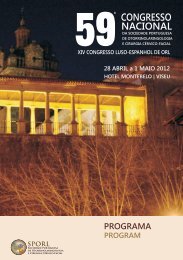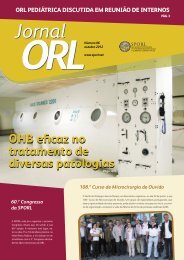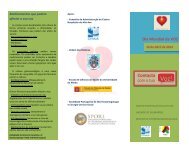datas limites para submeter comunicações científicas ... - SPORL
datas limites para submeter comunicações científicas ... - SPORL
datas limites para submeter comunicações científicas ... - SPORL
Create successful ePaper yourself
Turn your PDF publications into a flip-book with our unique Google optimized e-Paper software.
inites atróficas, desconforto respiratório, hemorragias<br />
e necessidade de tamponamento, formação de crostas e<br />
sinéquias 2,6,7,8,10,11,16 .<br />
A radiofrequência é uma técnica bem tolerada que<br />
se pode realizar de forma segura e ambulatória com<br />
anestesia local. Com uma energia que varia entre 400-<br />
500J e uma potência entre 10-18W, é produzida uma<br />
lesão térmica entre 2-4mm em torno ao eléctrodo 2,6,11 .<br />
Contrariamente à cirurgia por laser ou electrocauterização,<br />
que produzem temperaturas que podem alcançar os<br />
800ºC, a técnica da radiofrequência utiliza uma menor<br />
potencia <strong>para</strong> gerar uma temperatura que pode chegar<br />
aos 85ºC (produzindo a desnaturalização dos tecidos<br />
a 49,5º). Isto permite um maior controlo da lesão e<br />
um menor risco de destruição da mucosa adjacente ou<br />
necrose da arquitectura óssea do corneto 11 .<br />
Deste modo a redução do volume do corneto é<br />
consequência da retracção resultante da necrose do<br />
tecido que se produz com a lesão térmica.<br />
A radiofrequência apresenta como vantagens o facto<br />
de que se realiza de forma fácil e rápida com anestesia<br />
local. Como consequência esta intervenção dispensa<br />
hospitalização. Não necessita tamponamento nasal<br />
evitando deste modo a maceração da mucosa nasal e<br />
mal-estar do paciente. Além disso, esta técnica permite<br />
a preservação do epitélio nasal, não produz alterações<br />
no aclaramento mucociliar e não provoca aumento de<br />
secreções nem formação de crostas 3 . Os cuidados pós-<br />
-operatórios são simples, incluindo apenas lavagens<br />
nasais com soro e aplicação de prednisolona em pomada<br />
nasal. Torna-se também importante referir a possibilidade<br />
de repetir o procedimento noutras ocasiões se a melhoria<br />
da sintomatologia não for suficiente 19 .<br />
Apesar de aumento da sensação de congestionamento<br />
nasal na primeira semana em 83% dos pacientes existe<br />
um resultado satisfatório às oito semanas 19 .<br />
CONCLUSÃO<br />
Concluímos deste modo que a radiofrequência como<br />
tratamento da obstrução nasal por hipertrofia de<br />
cornetos inferiores, que não responde a tratamento<br />
médico, é uma técnica segura, minimamente invasiva<br />
e com baixo índice de complicações. Apresenta deste<br />
modo perspectivas favoráveis sendo o seu uso fácil e os<br />
resultados obtidos muito satisfatórios.<br />
246 REVISTA PORTUGUESA DE OTORRINOLARINGOLOGIA E CIRURGIA CÉRVICO-FACIAL<br />
Referências Bibliográficas:<br />
1.Atef A, Mosleh M, El Bosraty H, Abd El Fatah G, Fathi A. Bipolar<br />
radiofrequency volumetric tissue reduction of inferior turbinate: does<br />
the number of treatment sessions influence the final outcome?<br />
Am Rhinol. 2006 Jan-Feb; 20(1):25-31<br />
2.Liu CM, Tan CD, Lee FP, Lin KN, Huang HM. Microdesbrider-assisted<br />
versus radiofrequency-assisted inferior turbinoplasty.<br />
Laryngoscope, 2009 Feb; 119 (2): 414-8<br />
3.Hytönen ML, Bäck LJ, Malmivaara AV, Roine RP. Radiofrequency<br />
termal ablation for patients with nasal symptoms: a systematic review<br />
of effectiveness and complications.<br />
4.J. Basterra Alegría, M. Armengot Carceller. Piramide nasal, fosas nasals y<br />
senos <strong>para</strong>nasales: bases embriológicas, anatomía y fisiología aplicada.<br />
Tratado de Otorrinolaringología y Patología Cervicofacial, 2009 Elsevier<br />
España, S.L.<br />
5.J. S. Lacroix, B.N. Landis. Fisiología de la mucosa respiratoria<br />
rinosinusal y trastornos funcionales<br />
Enciclopedia Medico Cirurgica, Elsevier Masson, 2010. 20-290-A-10.<br />
6.Cavaliere M, Mottola G, Iemma M. Comparison of the effectiveness<br />
and safety of radiofrequency turbinoplasty and traditional surgical<br />
technique in treatment of inferior turbinate hypertrophy.<br />
Otolaryngol. Head Neck Surg. 2005 Dec; 133(6): 972-8<br />
Eur Arch Otorhinolaryngol. 2009 Aug; 266(8): 12257-66. Epub 2009 Feb<br />
3. Review.<br />
7.Yilmaz M, Kemaloglu YK, Baysal E, Tutar H. Radiofrequency for inferior<br />
turbinate hypertrophy: could its long-term effect be predicted with a<br />
preopertative topical vasoconstrictor drop test?<br />
Am Rhinol. 2006 Jan-Feb; 20(1):32-5<br />
8.Bhandarkar ND, Smith TL. Outcomes of surgery for inferior turbinate<br />
hypertrophy.<br />
Curr Opin Otolaryngol Head Neck Surg. 2010 Feb; 18 (1): 59-53<br />
9.Harril WC, Pillsbury HC 3rd, McGuirt WF, Stewart MG. Radiofrequency<br />
turbinate reduction: a NOSE evaluation<br />
Laryngoscope. 2007 Nov; 117 (11):1912-9<br />
10.Salzano FA, Mora R, Dellepiane M, Zannis I, Salzano G, Moran E, Salami<br />
A. Radiofrequency, high-frequency, and electrocautery treatments vs<br />
partial inferior turbinotomy: microscopic and macroscopic effects on<br />
nasal mucosa.<br />
Arch Otolaryngol Head and Neck Surg. 2009 Aug; 135 (8): 752-8<br />
11.Cavaliere M, Mottola G, Iemma M. Monopolar and bipolar<br />
radiofrequency thermal ablation of inferior turbinates: 20month follow-up.<br />
Otolaryngol. Head Neck Surg. 2007 Aug; 137(2): 256-63<br />
12.Farmer SE, Eccles R. Understanding submucosal electrosurgery for<br />
treatment of nasal turbinate enlargement.<br />
J. Laryngol Otol. 2007 Jul; 121 (7): 615-22. Epub 2006 Nov 28. Review<br />
13.Nease CJ, Krempl GA. Radiofrequency treatment of turbinate<br />
hypertrophy: a randomized, blinded, placebo-controlled clinical trial.<br />
Otolaryngol Head and Neck Surg. 2004 Mar; 130 (3): 291-9<br />
14.Kezirian EJ, Powell NB, Riley RW, Hester JE. Incidence of complications<br />
in radiofrequency treatment of the upper airway.<br />
15.Jacquelynne Corey, John Pallanch. Evaluation of nasal breathing<br />
function with objective airway testing.<br />
Cummings Otolaryngology, Head and Neck Surgery 5th edition<br />
16.Seren E. Effect of radiofrequency volumetric tissue reduction of<br />
inferior turbinate on expiratory nasal sound frequency.<br />
Am J Rhinol Allergy. 2009 May-Jun; 23(3):316-20<br />
17.Roth M, Kennedy DW. The case for inferior turbinate preservation.<br />
Rhinology a state of art. 1994 Kluger publications: 109-112.<br />
18.Janda P, Sroka R, Betz CS, Baumgartner R, Leunig A. Laser treatment<br />
for hyperplastic inferior nasal turbinates: a review. Lasers Surg. Med<br />
2001;285(5):129-39<br />
19.Porter MW, Hales NW, Nease CJ, Krempl GA. Long-term results of<br />
inferior turbinate hypertrophy with radiofrequency treatment: a new<br />
standard of care?<br />
Laryngoscope, 2006 Apr. 116(4): 554-7



